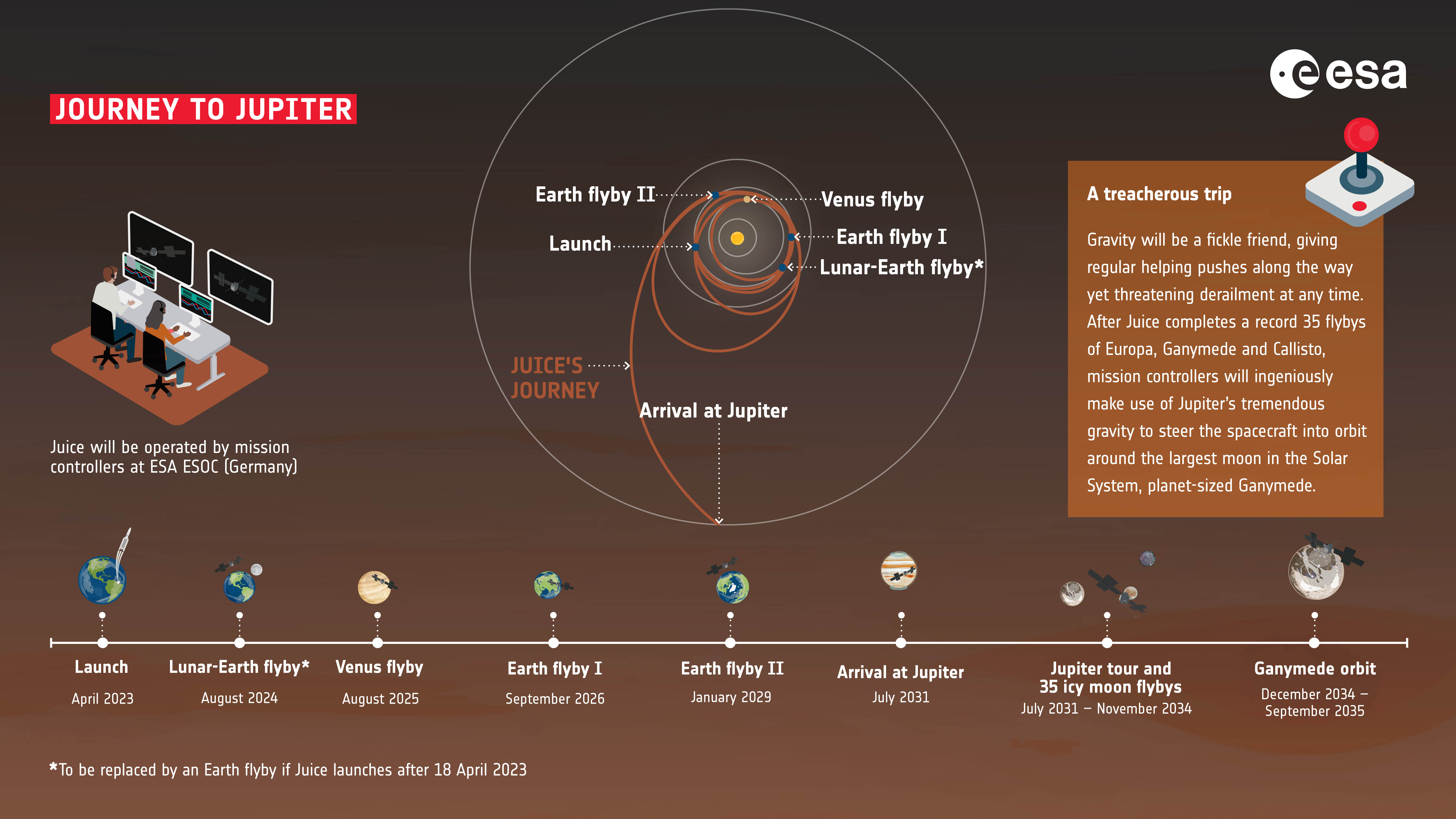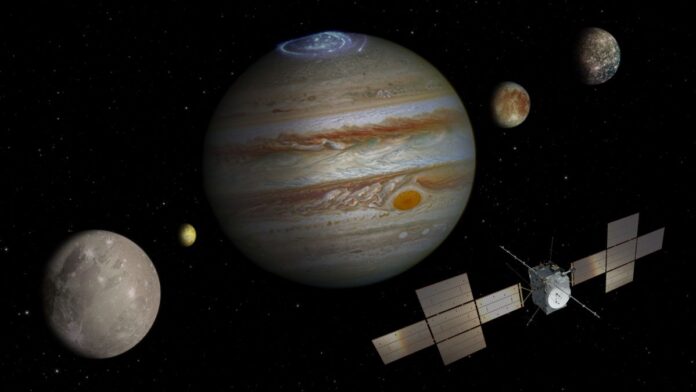Set to blast off on Thursday (April 13), the Jupiter Icy Moons Explorer (JUICE) will embark on an eight-year journey to Jupiter, with the spacecraft estimated to arrive at the gas giant in July 2031.
The European Space Agency (ESA) spacecraft will make observations of Jupiter and three of its large ocean-bearing moons — Ganymede, Callisto and Europa — characterizing the Jovian system in great detail.
Jupiter orbits, on average (opens in new tab), about 444 million miles (715 million kilometers) from Earth, so it’s clearly more than a hop, skip and jump to the giant planet. But other missions have made the trip from Earth to Jupiter much more quickly than JUICE will.
Related: Facts about Europe’s JUICE Jupiter mission
As it turns out, one of the main factors dictating the travel time to Jupiter is whether a spacecraft will fly by the gas giant or insert into orbit for a relatively long-term mission.
The first spacecraft to journey from Earth to Jupiter was NASA’s Pioneer 10, which launched on March 3, 1972, and made its flyby of Jupiter on Dec. 3, 1973, meaning it reached the gas giant in just 640 days. Pioneer 11 was even faster on its flyby trajectory, reaching Jupiter in just 606 days.
Then there are the orbiters, which must be more deliberate than flyby craft because they need to be going slowly enough at journey’s end to be captured by Jupiter’s gravity. JUICE will journey for eight years through deep space. NASA’s Galileo probe took about six years to trek to Jupiter, launching in October 1989 and arriving in orbit in December 1995. The agency’s Juno spacecraft launched in August 2011 and reached its destination in July 2016.
Such variations in Jupiter orbiter travel times stem from several factors. For example, the distance between Earth and Jupiter varies greatly over time. In addition, orbiter missions don’t take direct paths to the giant planet; they travel a scenic route around the inner solar system, flying by other planets to get speed-boosting, trajectory-sculpting “gravity assists.”
For instance, Galileo traveled about 2.5 billion miles (4 billion km) to get to the gas giant, taking gravity assists from Venus, Earth, and even the asteroid Gaspra along the way. JUICE will employ a similar strategy.
The mission “will do a complex sequence of gravity assist maneuvers, starting one year after launch, taking moon and Earth gravity assists, both bodies at the same time to get the extra energy,” ESA scientist Alessandro Atzei said during a JUICE press briefing on April 6. “And then we have a Venus flyby gravity assist [and] two more Earth gravity assists in 2026 and 2029 to arrive at Jupiter in the distant July of 2031.”
Related: How gravity assists work
What is a gravity assist?
Gravity assists are a flyby technique that can boost a spacecraft’s momentum. Mission planners use gravity assists to send spacecraft on journeys that wouldn’t be feasible with a direct route; they would require too much fuel, for example.
A gravity assist can also be used to “steal” momentum from a spacecraft. The Galileo mission is an example of this; the NASA craft reduced its energy relative to Jupiter by flying in front of the volcanic Jovian moon Io. Propellant is used both to speed up and slow down spacecraft, so an energy-stealing gravity assist can reduce the amount of propellant that a spacecraft needs to use to insert itself into orbit.
A gravity assist works in a similar way to a ball rolling down a hill into a valley, via a switch between gravitational potential energy and kinetic energy, the Planetary Society explains (opens in new tab). As a spacecraft approaches a planet, it falls into the celestial body’s gravity well and gains kinetic energy, speeding up while losing gravitational potential energy. The spacecraft then leaves the planet on a new trajectory, which can be adjusted by altering the distance at which the craft passes the planet. Planetary flybys can therefore have a “slingshot effect” on a spacecraft, helping them get the most out of their limited fuel supplies.
JUICE is one such spacecraft.
“We simply do not have enough energy [at launch] to go in a more direct orbit [around Jupiter], so we need to do all these gravity maneuvers in order to gradually increase the energy of the spacecraft in order to reach Jupiter,” Atzei said.
The extra energy imparted to the spacecraft has to come from somewhere — the planet’s motion. The mass difference between a spacecraft and a planet is so great, however, that the resulting slowdown of the planet is so small as to be virtually immeasurable.
As an example, the Planetary Society says that when NASA’s Voyager 1 made its gravity-assist flyby of Jupiter in 1979, the gas giant slowed in its orbit by about 0.0000000000000000000000010 kilometers per second while Voyager 1 got a 10 kilometer per second boost in speed.

The inner planets lend a hand: JUICE’s gravity assists
To get to Jupiter JUICE will receive a total of four inner solar system gravity assists, from the moon, Earth and Venus. (Back in 2017, ESA was proposing a fifth and final gravity assist from Mars around three years before reaching Jupiter, but that’s no longer in the plan.)
JUICE will head toward its first gravity assist in August 2024 after completing its first solar orbit, and this will be a very special one for the ESA craft and for space exploration in general. This will be a combined moon and Earth gravity assist, officially called a lunar-Earth gravity assist (LEGA), the first time such an operation has been performed.
“The first one will be very challenging, because it will be not just an Earth gravity assist — a lunar-Earth gravity assist, which means that we have to pass by Earth and the moon at the same time,” Atzei added. “So this will be the most accurate gravity assist maneuver ever done.”
The next gravity assist for JUICE will occur a year later, in August 2025, when the spacecraft gets a boost from the second planet from the sun, Venus.
The spacecraft’s next two gravity assists will both come from Earth. JUICE will fly by our planet in September 2026 and will then make one final visit to Earth in January 2029, when it gets yet another gravitational “kick,” its last one before reaching Jupiter.
That won’t be the end of the gravity assists for JUICE, however. Even after it has begun its scientific mission, the spacecraft will need to perform gravity assists to get to the moons Ganymede, Europa and Callisto. (JUICE will orbit Jupiter initially, performing multiple flybys of those three moons. It will then shift to orbiting Ganymede in 2035, becoming the first probe ever to orbit a moon other than Earth’s.)
“The gravity assists have to be precise, but we have very capable people in the Mission Control Unit, and they’re accustomed to these maneuvers,” Atzei added.
Follow us on Twitter @Spacedotcom (opens in new tab) and on Facebook (opens in new tab).

